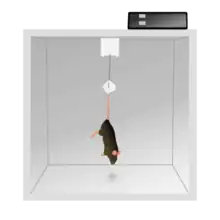Tail suspension test

| Animal testing |
|---|
 |
| Main articles |
|
| Testing on |
|
| Issues |
|
| Cases |
|
| Companies |
|
| Groups/campaigns |
|
| Writers/activists |
|
| Categories |
|
The tail suspension test (TST) is an experimental method used in scientific research to measure stress in rodents. It is based on the observation that if a rat is subjected to short term inescapable stress then the rat will become immobile. It is used to measure the effectiveness of antidepressant-like agents but there is significant controversy over its interpretation and usefulness.
History
The TST was introduced in 1985 due to the popularity of a similar test called the forced swim test (FST). However this test only recently became popular in the 2000s where data has shown that animals do show a change in behavior when injected with antidepressants. TST is more reliable when done in conjunction with other depression models such as FST, learned helplessness, anhedonia models and olfactory bulbectomy.[1]
Modeling depression
Depression is a complex multi-faceted disorder with symptoms that can have multiple causes such as psychological, behavioral, and genetics. Since there are so many variables it is hard to model in a lab setting. Patients suffering from depression do not always show the same set of symptoms.
Another difficulty in modeling depression is that psychiatrists who clinically diagnose depression follow the Diagnostic and Statistical Manual (DSM IV) of the American Psychiatric Association, which involves self-reporting from patients on how they feel. Since animals cannot explain to us how they feel, animals cannot be diagnosed as clinically depressed.[2]
While there are theories that animals can experience depression it is important to keep in mind that human brains are much more complex than rat brains. Since the brains are different the way emotion is processed could also be different. These uncertainties make it difficult to determine if animals can experience depression.[3]
However, there are symptoms that can be modeled in a lab setting, one of which is stress induced immobilization. If a rodent is subjected to the short term inescapable stress of being suspended in the air it will develop an immobile posture. If antidepressant agents are administered before the test, the animal will struggle for a longer period of time than if not.[1]
Immobility in the TST is defined as when the animal doesn’t want to put in the effort to try to escape. This represents a common symptom in depression called learned helplessness in which individuals who suffer from continued and unavoidable negative stimuli decrease their attempts to avoid those stimuli.[1]
Procedure
The animal is hung from a tube by its tail for five minutes approximately 10 cm away from the ground. During this time the animal will try to escape and reach for the ground. The time it takes until it remains immobile is measured. Each animal is tested only once and out of view from the other animals. Within the study there should be two sets of rats, one group which is the control which has been injected with saline and the group being tested which has been injected with the antidepressant-like agents.[4]
Controversy
There are mixed opinions about the TST. A common criticism is that it can be weeks before a noticeable effect is observed in patients who take antidepressants regularly, however the TST only measures one acute antidepressant dose for 5–6 minutes.
The TST has predictive reliability for known antidepressant agents. However, when testing drugs of unknown mechanisms, the prediction rate is unclear. While the TST detects NK1 receptor antagonists, which have known antidepressant action, it doesn't detect CRF1 receptor antagonists which also have antidepressant functions.
Difference from the forced swim test
TST is more sensitive to antidepressant agents than the FST because the animal will remain immobile longer in the TST than the FST.[1] The FST is not as reliable as the TST because the immobility in the animal could be due to the shock of being dropped in water. This also risks hypothermia.[5] While the mechanisms through which the TST and FST produce stress are unknown it is clear that while overlapping the tests produce immobility through stress differently.
See also
- Animal models of depression
- Behavioural despair test
- Learned helplessness
- Open field (animal test)
References
- 1 2 3 4 Cryan, John F.; Mombereau, Cedric; Vassout, Annick (2005). "The tail suspension test as a model for assessing antidepressant activity: Review of pharmacological and genetic studies in mice". Neuroscience and Biobehavioral Reviews. 29 (4–5): 571–625. doi:10.1016/j.neubiorev.2005.03.009. PMID 15890404.
- ↑ American Psychiatric Association (2013). Diagnostic and Statistical Manual of Mental Disorders: DSM-5 (fifth ed.). Washington D.C.: American Psychiatric Association.
- ↑ Cryan, J F; Mombereau, C (13 January 2004). "In search of a depressed mouse: utility of models for studying depression-related behavior in genetically modified mice". Molecular Psychiatry. 9 (4): 326–357. doi:10.1038/sj.mp.4001457. PMID 14743184.
- ↑ "Tail Suspension Test". Penn State Animal Resource Program. Retrieved 30 March 2016.
- ↑ Liu, X; Peprah, D; Gershenfield, H.K (2003). "Tail-suspension induced hyperthermia: a new measure of stress reactivity". J Psychiatr Res. 37 (3): 249–259. doi:10.1016/s0022-3956(03)00004-9.